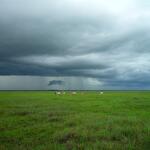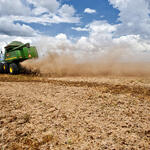- Date: 27 January 2021
- Author: Katherine Devine, Director of Business Case Development, WWF
The Possibility Is Closer than You Might Think
Many large companies have made environmental commitments to reduce embedded greenhouse gas emissions in the products they make or sell, yet are struggling to reach them. Scope 3 emissions pose a particular set of challenges—all the indirect emissions that occur both up and downstream in a company’s value chain, including from primary production, such as those emitted while producing milk on dairy farms. Within the food industry, supply chains are complex, with many ingredients going into diverse product portfolios. The dairy industry’s Net Zero Initiative¹ (NZI) has established the goal of reaching net zero GHG emissions by 2050 and has set a bold agenda to achieve this goal. Recent analysis conducted by The Markets Institute @ World Wildlife Fund—based on assumptions and data shared by stakeholders in the dairy industry—demonstrates that achieving net zero for large farms is possible with the right practices, incentives, and policies within five years. If businesses also step up to make investments and collaborate with dairy farmers in their supply chain, the potential to reach these goals can become even more tangible.
- Date: 09 January 2020
- Author: Jason Clay
The Markets Institute at WWF identifies global issues and emerging trends around the most pressing challenges of our time to help us all learn and shift faster. As always, we'll be tracking a wide variety of food and soft commodity issues, trends, and tools as we move into 2020, dubbed the super-year for the environment. We know we will see more political volatility and financial crises, and the impacts of climate change to not only be felt more deeply but also recognized for what they are—a ticking time bomb for the future so long as they are not addressed. Here are just a few of the other issues, trends and tools we will be tracking this year:
- Date: 01 January 2018
- Author: Jason Clay, SVP Markets, Exec Director of the Markets Institute
The Markets Institute at WWF identifies global issues, trends, and tools around the most pressing challenges of our time. Each year we release a list of what we see as the top emerging industry developments that may not be apparent to help stakeholders stay ahead of the curve, and to help us all shift faster.
The lists are identified through research, interviews, data analysis, and discussions with our Thought Leader Group. Here are the top issues, trends, and tools to keep an eye on in 2018:
ISSUES
Trade wars
With the recent resurfacing of nationalism around the world, we should expect an increase in trade wars as countries use trade to negotiate many different issues including global parity around cost of production as well as positioning countries to support domestic political platforms and constituencies. If/when trade wars come to include food—whether to close borders entirely or even just limit exports—then it will most certainly cause environmental impacts.
Plastics and food waste
The rush to limit plastic in the environment and particularly plastic ending up in the oceans is unprecedented. The full extent of the environmental impacts of plastic are only beginning to be understood. However, plastic does have several benefits, especially when it comes to food in terms of both safety and improved storage life. We need to be careful that we don’t move so far to remove plastics that we begin to increase food loss and waste. We need to find ways to recreate the benefits and convenience of plastic, or we need to find ways to keep plastics out of the environment or both.
From traceability to transparency
For several years, companies have become more and more interested in where their products are produced. Certification and verification systems do this (to some extent), but they are expensive and often proprietary, so many different systems have been created including—but not limited to—Blockchain. The traceability systems, however, rarely go all the way to the farm where production happens, or even further back to feed and other inputs. And now companies are beginning to realize that it is probably more important to know how the product is produced as where it is produced.
The rise of urban and controlled environment agriculture
There are hundreds of vertical, soilless agriculture operations in the US and thousands around the world. These operations offer the opportunity of producing food in urban areas, in food deserts, and in areas with severe water shortages. They also have the potential to reduce food loss and increase shelf life. While the number of species grown is still rather small and dominated by leafy greens, it is broadening. The cost of production remains high, but the operations are akin to that of solar and wind power in the 1970s. As the industry grows and people innovate, the costs will go down and these systems will be more affordable and more versatile. Even better if the actors can share knowledge on certain technology and grow more quickly through collaboration.
Finance resilience
The impacts of climate change, both chronic and extreme weather events, have occurred more quickly than anyone thought. We are already seeing undeniable impacts on production, livelihoods, and nutrition. Two places where this is most pronounced are with smallholder producers of tree crops: cocoa in West Africa and coffee in Central America. Many producers are beginning to struggle as their products and production systems falter in the face of unpredictable rains and drought and the spread of pests and diseases. Governments have generally reduced funding for food and agriculture just when they need to be increasing it. Companies need to find ways to invest in the producers in their supply chains not just for traceability and transparency but also for resiliency.
Cyber warfare, food security
To date, cyber-attacks have largely ignored food and food security targets. However, as food delivery via e-commerce platforms grows, the potential for cyber-attacks increases. As trade becomes more politicized, food production also becomes a bigger target. Finally, as food productions increasingly depends on electricity or digitally based systems for irrigation, feeding, or detection, cyber warfare targeting food systems will become a lot more common.
TRENDS
Food e-commerce
E-commerce for food has grown considerably in recent years. It started with fast food delivery services like pizza in the US. But it has expanded to include uncooked food home delivery, mostly in China starting with Alibaba, and then on to the US with Amazon, Blue Apron, and more. Some grocery retailers have been delivering food for over a decade and they are stepping up the pace to compete. This trend will only expand.
Changing consumption patterns
Consumption patterns have shifted for as long as people have been exposed to different foods and types of cuisine. This of course increased as mass transportation became more common, and it has increased even more as social media has connected people around the world through food. Today, health and nutrition concerns, as well as age also influence consumption. However, as food becomes more global and even niche markets can be quite large, global finance is also increasing the pace and scale of change. When coupled with high net worth individuals with strong food preferences and opinions, even more funding becomes available.
M&A over R&D
In the face of climate change, the rise of nationalism and increasing trade wars, companies are investing increasing amounts in mergers and acquisitions and less in research and development. It is cheaper to buy innovation and market share than it is to build it out from scratch. There are simply too many things that can be relevant to a viable company today than ever before.
Go North (or South), young man
Climate change is driving chronic changes in crop growing zones, winter freezes, and average rainfall as well as increasing extreme weather like hurricanes, droughts, floods, fires, and dust bowls. Crops are moving North in North America but also in Europe and Asia, and South in Africa and Latin America. And habitat conversion continues and GHG emissions increase.
Precompetitive platform uptake
The number of precompetitive platforms has increased rapidly as companies begin to realize that many of the most important issues they must address are shared with others, as are the solutions. Sustainability is a precompetitive issue. Companies are responsible for what they do directly, however, most of the biggest impact of food products are where and how raw materials are produced and then consumed. What happens in the middle has fewer impacts. No company can solve production and consumption issues alone. Climate change and other crises will spur more collaboration.
TOOLS
Common protein and nutrition metrics
As questions on healthier and more nutritious diets become more common, calories will no longer be a sufficient metric for malnourishment. We need a common set of metrics to compare proteins and other key nutrients from very different kinds of foods so that we can compare apples to apples, so to speak. Many plants have proteins—are they the right ones? Many animal proteins have nutrients—are they the right ones? At what ages are different proteins and nutrients most important in human lives? How many of these proteins and nutrients already exist in household gardens of local communities and indigenous people but have never been studied by science? Is there a way to create averages or ranges, or is every individual truly unique?
CRISPR & gene editing
CRISPR and other types of gene editing allow for the selection and replication of traits that already exist within a genome, e.g. productivity, flavor profiles, and nutrient density. However, they are also tools that can be used to help make organisms more resilient in the face of climate change, e.g. drought or heat tolerance, disease resistance, or geographic and conditional variation. These same tools can be used to create GMOs, but their benefits can also come from working on single species. Whether that happens or not in some geographies will depend on if gene editing within a species is considered a GMO or not. Portable DNA sequencers are another genetic tool to keep an eye on, with potential for hunting down pests, testing for viruses, and bringing science directly into the hands of farmers.
Agrobots and tech
There have been a plethora of new robotic and other technology developments along the value chain. Drones monitor field conditions including soil moisture, plant health, and disease outbreaks at a fraction of the costs of humans, and very quickly with higher levels of certainty. Tractors drive themselves while also geo-spatially monitoring seeding rates and fertilizer applications, herbicide applications and pest issues, and productivity tied back to inputs used. Agrobots can be used to help determine optimal harvest times and increasingly, harvesting can be automated. Finally, distribution centers are automated and home food deliveries can be made by bots. There’s no question this will be a multibillion dollar industry in short order, but how it will impact labor and if/when it will price some farmers out of the business remains to be seen.
Science-based targets for supply chains
Many companies are making commitments to reduce GHG emissions to help limit global warming to below 2 degrees Celsius. They have started with scope 1 emissions (what they produce themselves onsite) and scope 2 emissions (the energy they purchase). However, in the food industry, scope 3 emissions (how raw materials are produced upstream and how products are consumed) are by far the largest contribution. As we have seen with other certification programs, making commitments is one thing, making change happen is quite another. If the food sector is going to make a meaningful contribution to prevent climate change, we need to find the right incentives.
Social media and misinformation
Social media has allowed the spread of misinformation at unprecedented levels. Couple that with the fact that more people seem to be driven by their own opinions or those of trusted friends than they are by science, and there’s a perfect storm of misinformation. This is a minefield for anyone interested in science-based solutions for the world’s most pressing problems, but it is increasingly difficult for government and the private sector to navigate this space. Social media and the underlying technology are powering the spread of misinformation, and at the end of the day the platforms intended to bring us together are leading to social polarization.
---
Stay tuned for what else we see this year, and help us keep an eye on the horizon.
If you haven't already, sign up for our weekly update to see how these trends evolve.
- Date: 01 January 2017
- Author: Jason Clay, SVP Markets, Exec Director of the Markets Institute
The Markets Institute at WWF identifies global issues, trends, and tools around the most pressing challenges of our time. Each year we release a list of what we see as the top emerging industry developments that may not be apparent to help stakeholders stay ahead of the curve, and to help us all shift faster.
The lists are identified through research, interviews, data analysis, and discussions with our Thought Leader Group. Here are the top issues, trends, and tools to keep an eye on in 2017:
ISSUES
Climate change as a threat multiplier
We are seeing more and more anecdotal evidence of the impacts of climate change. Nowhere more so perhaps than in the global food system. There are more pests and pathogens, weeds are healthier, seasons more variable, and there are more extreme weather events from drought to floods, hurricanes, tornados, dust bowls, fires, and more. We are also seeing the beginning of shifts in where crops are—or can be grown. Going forward, we need better systems to monitor climate impacts so we can begin to anticipate and get ahead of them.
Decentralization of global governance
Global governance systems are being undermined and replaced with bilateral arrangements and a more decentralized system. This can be seen most clearly with the World Trade Organization being moved aside by bilateral and regional trade deals. But it is also happening in several other ways. There are some issues that are truly global and that cannot be solved by one, two, or even a handful of countries. Everyone needs to be engaged. This is especially true of environmental issues—biodiversity loss knows no boundaries; neither does pollution, and GHG emissions, perhaps the biggest pollution issue of all, will not be solved without cooperation, rules of the game, measurement and continuous improvement, with everyone doing something.
Emerging zoonoses
It feels like zoonotic diseases have become a more regular occurrence. In fact, we have had an average of two every year for the past century. Except for the Spanish influenza, most of the outbreaks have not been global. However, it’s growing clearer that they are being caused by clearing natural habitat and forcing more biodiversity onto smaller amounts of land. New hosts are being found in the wild but also with the most common mammals—livestock and people. As we clear more land, encroach on more habitat, and raise more livestock, we can expect more outbreaks. And if hundred-year storms are now a twice-a-decade event, we can expect a big one, or more, on the horizon.
Microbiomes
We are at the beginning of a groundswell around microbiomes, whether it is the gut microbiome of people or animals, soil or even plant microbiomes. As we understand more about the microbiomes of different species, we have a much better idea about their role in nutrition, nutrient uptake and recycling, and the production of GHGs like methane. Microbiome research and understanding how they function will be key to changing diets of people and livestock, but also in how we feed plants and take advantage of natural processes to reduce soils amendments.
Trump & Bolsonaro: Wild Cards
No two national leaders reflect the rise of nationalism, protectionism, and the rollback of environmental protections more than Trump and Bolsonaro. Unfortunately, they are not alone, and others are likely to follow suit as we experience major pushback on globalization, as well as social and environmental agendas—and the polarization that each seems intent to encourage. Their governments look less like democracies and more like a “winner takes all” strategy. And, with these two it will get worse before it gets better; each has a constituency of loyal followers.
TRENDS
Plant-based Everything
As the movement, particularly in developed countries, toward plant-based diets gains momentum, we are seeing alternatives for anything that traditionally contained animal protein. Some of these attempts work and will begin to find market share. Most fail. But the trend is here to stay—plant-based diets will be an increasing share of the food market. The questions are how big it will become, where it will gain most tractions, how long will it take, and if they can keep the environmental impacts low if—and when—they start to scale.
Momentum from the Paris Accords
Coming out of the Paris COP, many companies have decided that they can’t wait for governments to start reducing GHG emissions. More and more companies are making commitments to reduce their own scope one emissions, as well as scope two three emissions. It is great to see this movement. The question is whether it will help drive government ambition higher.
Soil’s moment in the sun
It’s about time that the importance of soil is more widely recognized. With current farming techniques, without soil we would have no food. That is why soil (e.g. its health, erosion rates, nutrients, and biodiversity) is such an important biome for people. Regenerative agriculture, climate-smart ag, land stewardship, agroforestry, and eco-agriculture are all pushing for better soil management. Now, with the potential to pay farmers for improving soil (not for soil carbon per se, but reduced input use and increased efficiency and resiliency) rather than mining it, hopefully we will see vast improvements in productivity and reduced negative impacts.
Decline of regulation
With economic growth declining, the rise of nationalism, and the volatility of primary product pricing, most countries have less revenue and are cutting government. Many are pulling back precisely when the need to do more has never been greater, as social safety nets are disappearing and any gains for the poor are rolling back. In this vein, governments are also becoming laxer about enforcing existing regulations. This has resulted in a gradual, but pervasive increase of illegality in global food trade affecting both domestic and global food systems. It continues to go unchecked, hurting both producers and consumers, but also the planet.
Protein tradeoffs: land, sea
As people become more selective about protein sources, they are beginning to choose based not only on human health issues such as links to disease, aging, or the latest nutrition study in the news. Many are shifting from land-based proteins to those from the ocean. The real question is how does one compare proteins of different types of livestock with different seafoods, and then also production methods, e.g. free range or grain-fed and wild-caught or farmed. This trend will lead to more research about proteins and how they fit into personal nutrition plans.
Material accumulation vs. well-being
Increasingly, material accumulation is confused with well-being. This is true not just in developing countries where more people are being lifted out of poverty but also includes developed countries and the wealthy wherever they live. Displaying wealth in the form of things leads to accumulation and unnecessary consumption. It can be something as simple as having twenty t-shirts in a drawer, but only wearing three. And as things are displayed it becomes competitive and drives more accumulation. Unless people see the folly of this it only ends at the resource limits of the planet.
TOOLS
Crowdsourcing
Crowdsourcing is increasingly being tested and used in the US for a wide variety of needs from fundraising to research. Contributions through citizen science have led to the identification of new species, species distribution and population counts, and even things like weather patterns, the impacts of climate change, and the search for criminals. However, crowdsourcing is also being used to support peer-reviewed, primary scientific research, and eventually crowds may do more of the reviewing.
Personalized nutrition
Now that we can sequence everyone’s personal DNA, we can not only anticipate medical issues or inherited traits but can keep them in check if monitored. Now it is clear that it is possible to also understand the impact of diet on health and even anticipate and ‘prescribe’ personalized nutrition plans to abate certain health issues.
Precompetitive venture capital
When XPRIZE launched the space tourism prize, they discovered that many entrants didn’t have access to the capital they needed maximize their chances to win the $10 M prize. They did not win the contest, but after the prize was awarded, four of them launched IPOs and raised $2 B in venture to take their inventions to market. Realizing that they had missed an opportunity, the Foundation created BOLD Capital, a venture fund to invest in groups that qualified to compete for XPRIZEs. The goal was to create a fund that invested in all the horses in the race. This is a way to de-risk VC is going forward.
Forest carbon sequestration
As companies attempt to reduce their GHG emissions, many realize that there is no way that they can reduce their direct GHG emissions, so they are looking for other ways to make a meaningful contribution. While it doesn’t make sense for oil and automobile companies, even airlines or thermal power plants to invest in carbon sequestration, it might make sense for banks, insurance or IT companies to reduce global emissions by investing in reforesting degraded areas or forests that are being degraded or likely to be cut. This helps solve a carbon problem and rehabilitates degraded land for nature. But this should only happen in addition to setting a broader, transparent, science-based strategy to reduce emissions in their operations and across their supply chains.
---
Stay tuned for what else we see this year, and help us keep an eye on the horizon.
If you haven't already, sign up for our weekly update to see how these trends evolve.
- Date: 12 February 2015
- Author: Erin Simon, WWF
On Feb. 6, the Woodrow Wilson Center hosted a roundtable, “Innovative Partnerships to Improve China's Meat Supply Chains.” Speakers discussed how industry, policymakers, and NGOs can support the modernization of China's meat supply chains to ensure domestic and global food safety. As a part of that event, Erin Simon from World Wildlife Fund shared with the panel an innovative partnership between WWF and packaging company, Sealed Air, to minimize the environmental footprint of poultry, and to implement best practices for better food safety, sustainable packaging, storage, and retail distribution of poultry products in China.
See our new infographic for more information about the global effect of China's poultry industry (PDF).
- Date: 02 December 2014
Making sustainability a priority, the Marshik Dairy -- a fifth-generation family farm -- implemented a new, technologically advanced and energy efficient barn design on their 155-cow dairy. The new design included robotic milking facilities, energy efficient lighting and ventilation, and renewable wind and solar power.
- Date: 21 November 2014
- Author: Greg Koch, Director, Global Water Stewardship, The Coca-Cola Company

Greg Koch, The Coca-Cola Company
I did the unthinkable in London on Nov. 6; I spent a sunny, blue-sky day indoors. Cloudy, rainy weather seems to follow me whenever I get the chance to visit this great city, so it was tempting to stay outdoors.
No such luck and I was glad I didn’t.
I spent the day in the revitalized London Docklands at The Economist’s World Water Summit. The day was jam packed with impressive speakers, panel discussions and networking over tea breaks. Many of the leading voices and actors in the water space were present. Governments, development organizations, academia, civil society and industry were all well-represented. Importantly, there was also a wide geographic representation with participants from every continent (OK, not Antarctica but I did meet two people who had been there!).
- Date: 04 November 2014
- Author: Rod Snyder, president, Field to Market
One of the most significant challenges facing this generation is how we provide food, fiber and fuel for 9 billion people across the globe by 2050, while conserving finite natural resources.
Finding science-based solutions to sustainable food production is a complex and difficult task, one that requires collaboration and cooperation among all of us. One of the key steps is defining the sustainability framework, definitions, indicators and metrics for sustainable agriculture and food systems that can measure our continuous progress.
- Date: 19 June 2014
- Author: Bryn Baker, Manager of Renewable Energy, WWF
For the largest corporations in the United States, clean energy is business as usual. And it’s good for business and our planet. In fact, nearly half of the largest companies in the U.S. are capturing significant business value by cutting emissions and using clean forms of energy to power their operations.
A new report from WWF, Ceres, Calvert Investments and David Gardiner and Associates finds that, 43 percent, or 215 of the companies in the Fortune 500 have set targets in one of three categories: (1) greenhouse gas (GHG) reduction commitments, (2) energy efficiency, and (3) renewable energy.
Leaders such as Caterpillar, Dow Chemical, General Electric, General Motors, Procter & Gamble, Sprint, and Walmart have set targets across all three categories.
The largest companies in the Fortune 500 – the Fortune 100 – continue to lead: 60 percent of Fortune 100 companies have set clean energy and GHG reduction targets as of 2013. Since the first Power Forward report was released, companies like Apple and Pepsi have joined the ranks of other Fortune 100 companies with climate and clean energy targets.
The aggregate impact of the company actions is significant. Among the 53 Fortune 100 companies reporting on climate and energy targets to CDP (formerly the Carbon Disclosure Project), they are conservatively saving $1.1 billion annually through their emission reduction and renewable energy initiatives. In 2012 alone, these companies decreased their annual emissions by approximately 58.3 million metric tons of CO2 equivalent – comparable to retiring about 15 coal plants – saving them an average of $19 per ton of CO2 equivalent.

The scale of these savings is likely to keep climbing rapidly as more companies realize the potential for big cost reductions enabled by energy efficiency and renewable energy. Individual companies have already achieved significant savings and have high expectations going forward. For example, IBM has saved a cumulative $477 million through its annual energy conservation actions. Walmart expects to save $1 billion globally per year through its renewable energy and energy efficiency initiatives. Dell estimates that improvements in the efficiency of its products will save customers $1.1 billion annually. The trends are clear: leading companies are capturing business value by executing effective clean energy strategies, and with proven results, more are sure to join the pursuit.
- Date: 18 June 2013
- Author: Mike Robinson - General Motors
Not too long ago I suppose, it would have been hard to believe that General Motors and World Wildlife Fund could be in agreement on how to protect the planet. But with today’s release of The 3% Solution report by WWF and CDP, it has become clear to me that we are on the same page when it comes to many of the actions needed to halt the steady rise of the globe’s temperature.
I say this with confidence because the activity described in this report is similar to what we have been doing for the last three years – and I’m here to say that it works.









